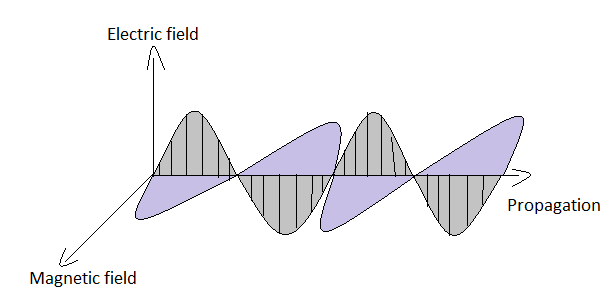
The magnetic field in a plane electromagnetic wave is given by $2\times {{10}^{-7}}\sin (0.5\times {{10}^{3}}x+1.5\times {{10}^{11}}t)$.This electromagnetic wave is
A. Visible light
B. Infrared
C. Microwave
D. Radio Wave
Answer
491.4k+ views
Hint: the above equation is of electromagnetic wave, by equating the above equation with the standard equation of electromagnetic wave we need to find wavelength, and by comparing it in the electromagnetic spectrum we can identify the type of waveform.
Formula used:
$E={{E}_{m}}\sin (kx+\omega t)$
$k=\dfrac{2\pi }{\lambda }$.
Complete solution:
The standard electromagnetic wave equation travelling in negative direction of x-axis is given by $E={{E}_{m}}\sin (kx+\omega t)$,

Here, ${{E}_{m}}$(amplitude), $k$(propagation constant), $\omega $(angular frequency) and $t$(time period).
Now, we know that $k=\dfrac{2\pi }{\lambda }$ and from the given equation by comparing $k=0.5\times {{10}^{3}}$ so,
$\dfrac{2\pi }{\lambda }=0.5\times {{10}^{3}}$
$\lambda =\dfrac{2\pi }{0.5\times {{10}^{3}}}=12.56\times {{10}^{-3}}m$
Electromagnetic energy travels in waves and spans a broad spectrum from very long radio waves to very short gamma rays and divided into seven different spectrum, the wavelength range of microwave is 1m to ${{10}^{-3}}m$ so our required range satisfied our wavelength.
Therefore, the answer is option C Microwave.
Additional information:
Light can be classified as a wave or particle due to its dual nature of wave-like properties and due to packets of energy called photons particle-like properties. One of the most significant properties of light is the polarization that is the electromagnetic field’s alignment.
Note:
The electric field is produced by a charged particle when a force is exerted by this electric field on other charged particles so the positive and negative charged particles accelerate In opposite direction same goes for magnetic field and electromagnetic field or wave is produced by these particles. Electromagnetic waves are the combination of the electric and magnetic fields moving in free space perpendicular to each other with the speed of light.
Formula used:
$E={{E}_{m}}\sin (kx+\omega t)$
$k=\dfrac{2\pi }{\lambda }$.
Complete solution:
The standard electromagnetic wave equation travelling in negative direction of x-axis is given by $E={{E}_{m}}\sin (kx+\omega t)$,

Here, ${{E}_{m}}$(amplitude), $k$(propagation constant), $\omega $(angular frequency) and $t$(time period).
Now, we know that $k=\dfrac{2\pi }{\lambda }$ and from the given equation by comparing $k=0.5\times {{10}^{3}}$ so,
$\dfrac{2\pi }{\lambda }=0.5\times {{10}^{3}}$
$\lambda =\dfrac{2\pi }{0.5\times {{10}^{3}}}=12.56\times {{10}^{-3}}m$
Electromagnetic energy travels in waves and spans a broad spectrum from very long radio waves to very short gamma rays and divided into seven different spectrum, the wavelength range of microwave is 1m to ${{10}^{-3}}m$ so our required range satisfied our wavelength.
Therefore, the answer is option C Microwave.
Additional information:
Light can be classified as a wave or particle due to its dual nature of wave-like properties and due to packets of energy called photons particle-like properties. One of the most significant properties of light is the polarization that is the electromagnetic field’s alignment.
Note:
The electric field is produced by a charged particle when a force is exerted by this electric field on other charged particles so the positive and negative charged particles accelerate In opposite direction same goes for magnetic field and electromagnetic field or wave is produced by these particles. Electromagnetic waves are the combination of the electric and magnetic fields moving in free space perpendicular to each other with the speed of light.
Recently Updated Pages
Master Class 12 Biology: Engaging Questions & Answers for Success

Master Class 12 Physics: Engaging Questions & Answers for Success

Master Class 12 Economics: Engaging Questions & Answers for Success

Master Class 12 Maths: Engaging Questions & Answers for Success

Master Class 11 Economics: Engaging Questions & Answers for Success

Master Class 11 Accountancy: Engaging Questions & Answers for Success

Trending doubts
Differentiate between homogeneous and heterogeneous class 12 chemistry CBSE

Which are the Top 10 Largest Countries of the World?

Why is the cell called the structural and functional class 12 biology CBSE

a Tabulate the differences in the characteristics of class 12 chemistry CBSE

Pomato is a Somatic hybrid b Allopolyploid c Natural class 12 biology CBSE

Who discovered the cell and how class 12 biology CBSE




